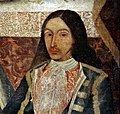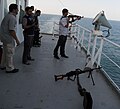Portal:Piracy
Introduction
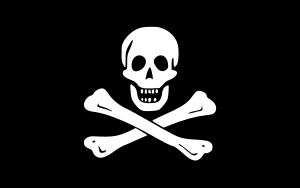
Piracy is an act of robbery or criminal violence by ship or boat-borne attackers upon another ship or a coastal area, typically with the goal of stealing cargo and other valuable goods. Those who conduct acts of piracy are called pirates, and vessels used for piracy are called pirate ships. The earliest documented instances of piracy were in the 14th century BC, when the Sea Peoples, a group of ocean raiders, attacked the ships of the Aegean and Mediterranean civilisations. Narrow channels which funnel shipping into predictable routes have long created opportunities for piracy, as well as for privateering and commerce raiding.
Historic examples of such areas include the waters of Gibraltar, the Strait of Malacca, Madagascar, the Gulf of Aden, and the English Channel, whose geographic structures facilitated pirate attacks. The term piracy generally refers to maritime piracy, although the term has been generalized to refer to acts committed on land, in the air, on computer networks, and (in science fiction) outer space. Piracy usually excludes crimes committed by the perpetrator on their own vessel (e.g. theft), as well as privateering, which implies authorization by a state government.
Piracy or pirating is the name of a specific crime under customary international law and also the name of a number of crimes under the municipal law of a number of states. In the 21st century, seaborne piracy against transport vessels remains a significant issue, with estimated worldwide losses of US$25 billion in 2023, increased from US$16 billion in 2004. (Full article...)
Selected biography -
Woodes Rogers (c. 1679 – 15 July 1732) was an English sea captain, privateer and colonial administrator who served as the governor of the Bahamas from 1718 to 1721 and again from 1728 to 1732. He is remembered as the captain of the vessel that rescued marooned Scottish sailor Alexander Selkirk, whose plight is generally believed to have inspired Daniel Defoe's novel Robinson Crusoe. Rogers came from an experienced seafaring family, grew up in Poole and Bristol, and served a marine apprenticeship to a Bristol sea captain. His father held shares in many ships, but he died when Rogers was in his mid-twenties, leaving Rogers in control of the family shipping business.
In 1707, Rogers was approached by Captain William Dampier, who sought support for a privateering voyage against the Spanish, with whom the British were at war. Rogers led the expedition, which consisted of two well-armed ships, Duke and Duchess, and was the captain of Duke. In three years, Rogers and his men went around the world, capturing several ships in the Pacific Ocean. En route, the expedition rescued Selkirk, finding him on Juan Fernández Island on 1 February 1709. When the expedition returned to England in October 1711, Rogers had circumnavigated the globe, while retaining his original ships and most of his men, and the investors in the expedition doubled their money. (Full article...)Selected article -
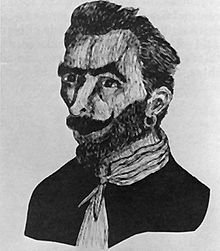
José Gaspar, also known by his nickname Gasparilla (supposedly lived c. 1756 – 1821), is a fictional Spanish pirate who terrorized the Gulf of Mexico from his base in southwest Florida during Florida's second Spanish period (1783 to 1821). Though details about his early life, motivations, and piratical exploits differ in various tellings, they agree that the 'Last of the Buccaneers" was a remarkably active pirate who amassed a huge fortune by taking many prizes and ransoming many hostages during his long career and that he died by leaping from his ship rather than face capture by the U.S. Navy, leaving behind his still-hidden treasure.
While Gaspar is a popular figure in Florida folklore, there is no evidence that he existed. No contemporary mention of his life or exploits has been found in Spanish or American ship logs, court records, newspapers, or other archives, and no physical artifacts linked to Gaspar have been discovered in the area where he supposedly established his "pirate kingdom." The earliest known written mention of José Gaspar was a short biography included in an early 1900s promotional brochure for the Gasparilla Inn on Gasparilla Island at Charlotte Harbor, the author of which freely admitted that the dramatic tale was a work of fiction "without a true fact in it". Subsequent retellings of the Gaspar legend are based upon this fanciful account, including the accidental inclusion of José Gaspar in a 1923 book on real pirates that has caused ongoing confusion about his historical authenticity. (Full article...)Did you know?
- ... that HMS Redpole, one of the aptly-named coffin brigs, sank in an action with a pirate vessel in August 1828?
- ... that Saudi Arabian broadcaster beoutQ pirated and resold beIN Sports programmes during the Qatar diplomatic crisis?
- ... that the developers of Hotline Miami 2: Wrong Number suggested that Australian customers pirate their game?
- ... that indigenous Australian artist Daniel Boyd has depicted colonial figures including Captain James Cook and Governor Arthur Phillip as pirates?
- ... that since 1904 the Gasparilla Pirate Festival in Tampa, Florida, has featured a pirate-themed parade?
- ... that in 2011, pirates were reported as raiding along the Danube River in the center of Europe?
- ... that English pirate Henry Every, who was sometimes known as Long Ben, was one of the few major pirate captains to retire with his loot without being arrested or killed in battle?
- ... that there is only one account of walking the plank?
Selected quotations
| “ | Come, let us make a hell of our own, and try how long we can bear it. | ” |
| — Blackbeard | ||
General images
Selected Jolly Roger
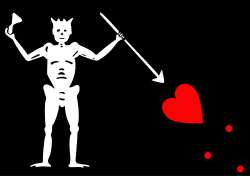
Subcategories
Topics
WikiProjects
Related portals
Things you can do
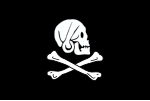
Contribute
- Work on piracy and pirate articles and help improve them to featured articles.
Expand
Join
WikiProject Piracy Requests
- eliminate red links from List of pirates
- expand Timeline of piracy, specifically to fill in vast gap between the 1890s to 2000s
- revise Bartholomew Roberts
- help with Requested articles and Expand articles
- help with Portal:Piracy
- Create Modern Piracy
Associated Wikimedia
The following Wikimedia Foundation sister projects provide more on this subject:
-
Commons
Free media repository -
Wikibooks
Free textbooks and manuals -
Wikidata
Free knowledge base -
Wikinews
Free-content news -
Wikiquote
Collection of quotations -
Wikisource
Free-content library -
Wikiversity
Free learning tools -
Wiktionary
Dictionary and thesaurus



